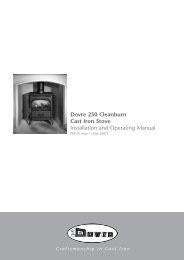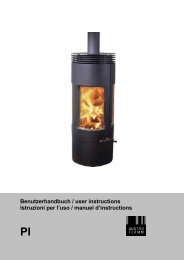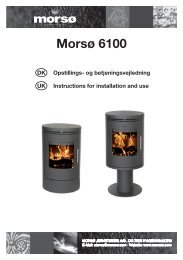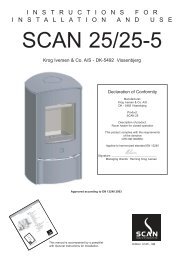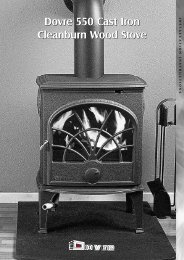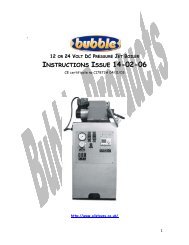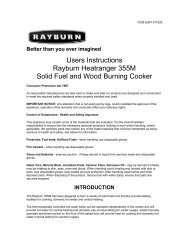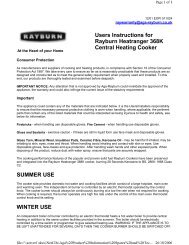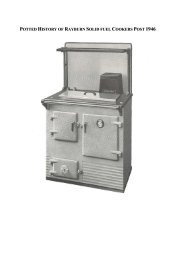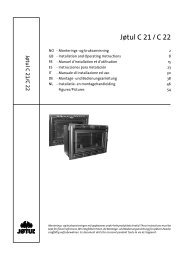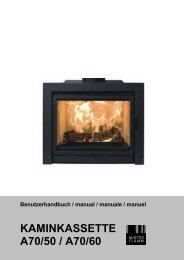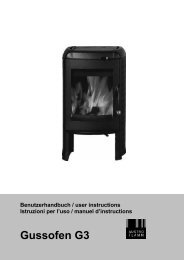Servicing Instructions for Rayburn Heatranger 360 K/D Central ...
Servicing Instructions for Rayburn Heatranger 360 K/D Central ...
Servicing Instructions for Rayburn Heatranger 360 K/D Central ...
- No tags were found...
You also want an ePaper? Increase the reach of your titles
YUMPU automatically turns print PDFs into web optimized ePapers that Google loves.
file://\\server1\docs\NetCDs\Aga%20Product%20In<strong>for</strong>mation%20Spares%20and%20Tec...Page 1 of 2626/10/200612/01 EINS 511011raywarranty@aga-rayburn.co.ukAt the Heart of your Home<strong>Servicing</strong> <strong>Instructions</strong> <strong>for</strong><strong>Rayburn</strong> <strong>Heatranger</strong> <strong>360</strong> K/D <strong>Central</strong> Heating CookerConsumer Protection Act 1987As manufacturers and suppliers of cooking and heating products, in compliance with Section 10 of the ConsumerProtection Act 1987, we take every care to ensure, as far as is reasonably practicable, that these products are sodesigned and constructed as to meet the general safety requirement when properly used and installed. To thisend, our products are thoroughly tested and examined be<strong>for</strong>e despatch.IMPORTANT NOTICE: Any alteration that is not approved by Aga-<strong>Rayburn</strong>, could invalidate the approval of theappliance, operation of the warranty and could also affect your statutory rights.Control of Substances - Health and Safety ImportantThis appliance may contain some of the materials that are indicated below.It is the Users/Installers responsibility to ensure that the necessary personal protective clothing is worn whenhandling, where applicable, the pertinent parts that contain any of the listed materials that could be interpreted asbeing injurious to health and safety, see below <strong>for</strong> in<strong>for</strong>mation.Firebricks, Fuel beds, Artificial Fuels - when handling use disposable gloves.Fire cement - when handling use disposable gloves.Glues and Sealants - exercise caution - if these are still in liquid <strong>for</strong>m use face mask and disposable gloves.Glass Yarn, Mineral Wool, Insulation Pads, Ceramic Fibre, Kerosene/Gas Oil - may be harmful if inhaled,may be irritating to skin, eyes, nose and throat. When handling avoid inhaling and contact with skin or eyes. Usedisposable gloves, face-masks and eye protection. After handling wash hands and other exposed parts. Whendisposing of the product, reduce dust with water spray, ensure that parts are securely wrapped.INTRODUCTIONThe <strong>Rayburn</strong> <strong>Heatranger</strong> <strong>360</strong> K/D central heating cooker is a simple robust appliance fitted with a reliable,proven, oil burner which is simple to maintain.To ensure the best per<strong>for</strong>mance from the cooker it should be serviced twice a year; be<strong>for</strong>e and after the heatingseason by a registered heating installer.An additional flueing and combustion chamber clean halfway through the heating season may be necessary insome cases. The cooker cannot be serviced whilst hot, so both oven and boiler thermostats should be turned offon the evening be<strong>for</strong>e the service visit.
file://\\server1\docs\NetCDs\Aga%20Product%20In<strong>for</strong>mation%20Spares%20and%20Tec...Page 2 of 2626/10/2006SERVICE SCHEDULE*IMPORTANT: ISOLATE ALL THE ELECTRICAL SUPPLIES TO THE APPLIANCE.2.1. Twice a Year.(a) Service clean of boiler heat exchanger flueways and oven and hotplate flueways together with firebricks -section 3.2(b) Change four loose fire bricks from winter to summer arrangement or vice versa - section 3.3(c) Removal of oil burner <strong>for</strong> cleaning and inspection -section 3.4(d) Burner <strong>Servicing</strong> - section 3.52.2 Annually.As above plus cleaning of oil pump strainer and fuel line strainer - section 3.5.2.2.3 Post Service Checks - section 6.Remember, when replacing a part on this appliance, use only spare parts that you can be assured con<strong>for</strong>m to thesafety and per<strong>for</strong>mance specification that we require. Do not use reconditioned or copy parts that have not beenclearly authorised by AGA-RAYBURN.INSTALLATION INSTRUCTIONS3.1 Preparation.Ensure that the cooker is cold by turning ‘OFF’ oven and boiler thermostats the evening be<strong>for</strong>e the service visit.Be<strong>for</strong>e removing service access covers or the oil burner ensure that ALL electrical supplies to the appliance havebeen turned OFF (switch off and remove plug).The burner can be removed without disconnecting the oil supply pipe. However if the filters are being cleaned or apressure gauge fitted to the pump then the oil supply should be turned OFF and arrangements made to catch anyoil which will leak from the oil pump.3.2 Flueway and Combustion Chamber CleaningLift out the hotplate with the handles provided (see fig. 1). Use the rake and brush to remove debris from theflueway above the oven and vacuum this area and the top of the firebrick baffles which are fitted above the burnerchamber (see fig 2).Carefully remove the two baffle bricks by separating them and lifting at the front (see fig 3).Either remove the burner (section 3.4) or protect the burner tube to prevent debris from falling into it.Remove the enamelled cover behind the LH insulating cover (see fig. 4) and remove the sealing plate (twist clipson LHS). Remove the boiler flue baffle to expose the boiler outlet flueway which should be scraped and brushedclean. Remove all debris which will have fallen into the combustion chamber.REASSEMBLY NOTE: Reassemble boiler flue baffle ensuring that narrow end of baffle marked ‘left’ is on the leftend of flueway and the location brackets are dropped into end sections of flueways. Refit sealing plate and theenamelled cover in reverse order of removal.
file://\\server1\docs\NetCDs\Aga%20Product%20In<strong>for</strong>mation%20Spares%20and%20Tec...Page 3 of 2626/10/2006Fig. 1 REMOVAL OF HOTPLATE DESN 510145 ‘A’Fig. 2 OVEN FLUEWAY CLEANING DESN 510233 ‘A’
file://\\server1\docs\NetCDs\Aga%20Product%20In<strong>for</strong>mation%20Spares%20and%20Tec...Page 4 of 2626/10/2006Fig. 3 REMOVAL OF BAFFLE BRICKS DESN 510218'A' AND DESN 510145 ‘A’Brush clean the ribs on the underside of the hotplate. Examine the rope seal in the hob on which the hotplate sits.Replace if frayed or damaged.Examine all firebricks <strong>for</strong> deterioration. Examine the fireboard floor of the combustion chamber and the chromeironplate on the right hand side of the combustion chamber. Both can be replaced if necessary (consult your<strong>Rayburn</strong> Agent).Be<strong>for</strong>e reassembling the baffle bricks and hotplate check that loose firebricks are fitted or removed depending onthe <strong>for</strong>thcoming season. Refit burner in reverse order of removal be<strong>for</strong>e commissioning.3.3 WINTER AND SUMMER FIREBRICKS(FIG. 5)During summer months it is necessary to fit four loose firebricks in the boiler to reduce the amount of hot waterproduced. It is recommended that these bricks are fitted and removed by the service engineer during the biannualservices at the end and start of the heating season. The following loose firebricks are supplied with the cooker <strong>for</strong>the summer season:Boiler Back firebrick 3/20291Boiler Side Rear firebrick 3/20289Boiler Side Front firebrick RO4F 321131Secondary Boiler Back firebrick RO4F321057
file://\\server1\docs\NetCDs\Aga%20Product%20In<strong>for</strong>mation%20Spares%20and%20Tec...Page 6 of 2626/10/20063.5 Burner <strong>Servicing</strong>3.5.1 Twice Yearly ServiceUndo the screw holding the blast tube to the burner (fig 9). Clean the diffuser and ignition electrodes taking carenot to wipe nozzle tip itself. Check electrode gap and adjust if necessary (see fig. 10). Clean inside burner, checkphoto-resistor, electrical connectors and that all grommets are in place.Reassemble3.5.2 Twice Yearly ServiceAnnually, clean the oil pump and flue line strainers in addition to the half yearly service.To Clean Oil Pump Strainer (fig 11).a. Turn OFF the oil line isolating valve near to the appliance.b. Break the flexible oil feed pipe joint as the inlet to the pump taking care to collect oil residue from the flexiblepipe and the pump.c. Remove electricity connection socket from the solenoid .d. Undo 4 x socket head screws which retain pump end cover.e. Gently pull off end cover.f. Remove pump strainer (filter) and wash with clean petrol or paraffin.g. Re-assemble element and end cover in reverse order of removal.To Clean Oil Line Filtera. Turn off the line isolating valve fitted prior to the oil line filter.b. Follow manufacturer’s instructions to remove filter element from the housing taking care to collect oil residuefrom the filter housing,c. Wash filter thoroughly in clean petrol or parrafin.d. Re-assemble filter in reverse order of removal.REPLACEMENT SPARESIMPORTANT: Isolate the electrical supplies to the appliance.4.1 Burner4.1.1 To Replace Burner Nozzle (see fig 10)N.B. Nozzles should not be replaced or dismantled <strong>for</strong> cleaning nozzle filters unnecessarily. This should normallybe done if, after carrying out the routine service, the combustion check does not give acceptable results. Nozzles
file://\\server1\docs\NetCDs\Aga%20Product%20In<strong>for</strong>mation%20Spares%20and%20Tec...Page 7 of 2626/10/2006should be handled with great care, using clean tools and clean hands.a. Remove burner assembly as in routine service section - 3.4.b. Unscrew nozzle from its holder with a correctly fitting tubular spanner to avoid damage to hexagon.c. Replace nozzle by a new one of the same size, spray angle and spray pattern.4.1.2 To Clean Burner Nozzle Filter (see fig. 10)a. Remove nozzle as in 4.1.1.b. Unscrew filter assembly from the rear of nozzle,c. Wash filter assembly in clean petrol or parrafin.d. Refit filter assembly to nozzle in reverse order of removal.Fig. 5 FITTING FIREBRICK FOR SUMMER USE DESN 510221
file://\\server1\docs\NetCDs\Aga%20Product%20In<strong>for</strong>mation%20Spares%20and%20Tec...Page 8 of 2626/10/2006Fig. 6 DESN 510234Fig. 7 REMOVAL OF BURNER ASSEMBLY DESN 510234
file://\\server1\docs\NetCDs\Aga%20Product%20In<strong>for</strong>mation%20Spares%20and%20Tec...Page 9 of 2626/10/2006Fig. 8 REMOVAL OF BURNER DESN 510236Fig. 9 BLAST TUBE REMOVAL DESN 510237
file://\\server1\docs\NetCDs\Aga%20Product%20In<strong>for</strong>mation%20Spares%20and%20Tec...Page 10 of 2626/10/2006Fig. 10 BURNER DETAIL DESN 510238
file://\\server1\docs\NetCDs\Aga%20Product%20In<strong>for</strong>mation%20Spares%20and%20Tec...Page 11 of 2626/10/2006Fig. 11 REMOVAL OF BURNER OIL PUMP STRAINER DESN 510239Fig. 12 REMOVAL OF OIL SOLENOID DESN 510240
file://\\server1\docs\NetCDs\Aga%20Product%20In<strong>for</strong>mation%20Spares%20and%20Tec...Page 12 of 2626/10/2006Fig. 13 COOKER CONTROLS DESN 510217 ‘C’4.1.3 To Replace Oil Pump Solenoid Valve (see fig 12)a. Turn OFF the oil line isolating valve near to the appliance.b. Remove burner assembly as in routine service section - 3.4.c. Pull off electricity connection socket from solenoid.d. Break the flexible oil feed pipe joint as the inset to the pump taking care to collect oil residue from the flexiblepipe and pump.e. Disengage retaining bolt from solenoid housing tube to remove solenoid coil.f. Unscrew solenoid housing tube from oil pump with a correctly fitting spanner to avoid damage to hexagon,taking care to collect oil residue from the oil pump.g. Fit replacement solenoid valve and assemble in reverse order of dismantling.4.1.4 Burner Re-commissioningBLEED AIR FROM OIL SUPPLY LINE. With flexible oil pipe disconnected at the pump end, open the stop valveslowly and run off some oil into a receptacle to establish an air free supply to the pump. Make the connection oiltight and leave valve open.Switch on Electricity.Turn the oven thermostat to 9. The burner should start and run on pre-purge <strong>for</strong> 7 to 15 seconds, with the ignitionspark energised, be<strong>for</strong>e the solenoid valve opens admitting oil and allowing it to fire. Until all the air from the oil
file://\\server1\docs\NetCDs\Aga%20Product%20In<strong>for</strong>mation%20Spares%20and%20Tec...Page 13 of 2626/10/2006pump is flushed out there may be some flame instability resulting in the burner locking out as indicated by thesignal light in the re-set button of the control box (see fig 13). In this event, wait at least one minute, then pressthe re-set button to re-start.Fig. 14 BURNER OIL PUMP CONNECTIONS DESN 510229Vent the Oil Pump (see fig 14)Place a suitable container beneath the pump to collect the excess oil.Slacken the bleed screw to release the trapped air in the pump. The burner will fire when the bleed screw is retightened.(N.B. The burner may have locked out be<strong>for</strong>e all the air was released; repeat as often as necessary.Check Oil Pressure (see Fig. 14)Place a suitable container beneath the pump to collect the excess oil.Unscrew and remove the bleed screw from the pump and fit an oil pressure gauge with R1/8 connection. Restorethe electricity supplies to the appliance. Switch on the burner and check the oil pressure on the pressure gauge. Ifthe pressure gauge is not indicating the correct reading then adjust the pressure by turning the pressure regulatorclockwise to increase, or anti-clockwise to decrease the pressure until the pressure gauge reads 10bar(145Ibf/In 2 ). Switch off the burner and disconnect all electrical supplies to the appliance. Remove the pressuregauge and replace the bleed screw.Check Combustion Air (see fig 15)Switch on electricity supplies to the appliance. Switch on the burner and set cooker/burner damper control knob toH (Heating). Remove the enamelled top plate cover panel (A) behind the LH insulating cover where a pluggingscrew will be seen. Remove this screw and insert sensing end of portable indicator to check the CO 2 (carbondioxide). Adjust the burner air intake until 11.5% CO 2 of flue gases is recorded on the indicator.
file://\\server1\docs\NetCDs\Aga%20Product%20In<strong>for</strong>mation%20Spares%20and%20Tec...Page 14 of 2626/10/2006Note: The outer burner door should be closed when checking CO 2 . Ensure that only the baffle bricks arefitted.Check SmokeRemove the CO 2 indicator and using the same hole <strong>for</strong> flue sampling. Insert the housing end of baccarach smokepump and check that the smoke in the flue exit does not exceed No.2 on the scale.Note: The outer burner door should be closed when checking level.Fig. 15 FLUE GAS SAMPLING AND COMBUSTION AIR ADJUSTMENT DESN 510231
file://\\server1\docs\NetCDs\Aga%20Product%20In<strong>for</strong>mation%20Spares%20and%20Tec...Page 15 of 2626/10/2006Fig. 16 THERMOSTAT MOUNTING AND PHAIL LOCATION DESN 510242 ‘A’4.2 THERMOSTAT REPLACEMENT (SEE FIG 16).4.2.1 To Remove Cooker (oven) Thermostata. Pull off the two thermostat knobs. Remove two pan head screws securing control cover to L.H. side panel andremove cover.b. Disconnect two electrical leads from the thermostat.c. Unscrew thermostat fixing screws to detach cooker (oven) thermostat from mounting plate.d. Open oven door and using a screwdriver, remove two fixing screws securing inner L.H. oven side to expose thelocated thermostat phial.e. Remove the phial securing screw and unclip thermostat phial from the L.H. side of roasting oven and resetphial to face across the oven width instead of facing in depth.f. Slacken the capillary securing clamp inside the oven and two capillary retaining brackets inside burner housing.g. Withdraw the capillary and phial carefully out of the oven, across the burner and out through the side casing.h. Fit replacement thermostat and assemble in reverse order of removal. Electrical leads to be reconnected aspreviously (see fig 18 <strong>for</strong> connections).4.2.2 Boiler Thermostat
file://\\server1\docs\NetCDs\Aga%20Product%20In<strong>for</strong>mation%20Spares%20and%20Tec...Page 16 of 2626/10/2006a. Pull off the two thermostat knobs. Remove two pan head screws securing control cover to L.H. side panel andremove cover.b. Remove two pan head screws securing rectangular cover to the rear top of the L.H. side panel and removecover to expose boiler and pump overrun thermostat phial housing pocket.c. Remove split pin from the pocket.d. Withdraw both boiler and pump overrun thermostat phials from the pocket, and separate the two phials fromone another.e. Disconnect two electrical leads from the thermostat.f. Unscrew thermostat spindle locknut to detach boiler thermostat from mounting plate.g. Fit replacement thermostat and assemble in reverse order of removal. Electrical leads to be reconnected aspreviously (see fig 18 <strong>for</strong> connections). The boiler and pump overrun thermostat phials should be assembledtogether be<strong>for</strong>e fitting into the pocket.4.2.3 To Remove Pump Overrun Thermostata. Pull off the two thermostat knobs. Remove two pan head screws securing control cover to L.H. side panel andremove cover.b. Remove two pan head screws securing rectangular cover to the rear top of the L.H. side panel and removecover to expose boiler and pump overrun thermostat phial housing pocket.c. Remove split pin from pocket.d. Withdraw both boiler and pump overrun thermostat phials from the pocket, and separate the two phials fromone another.e. Disconnect two electrical leads from the thermostat.f. Unscrew thermostat spindle locknut to detach overheat thermostat from mounting plate.g. Fit replacement thermostat and assemble in reverse order of removal. Electrical leads to be reconnected aspreviously (see fig. 18 <strong>for</strong> connections). The boiler and pump overrun thermostat phials should be assembledtogether be<strong>for</strong>e fitting into the pocket.4.3 Control Circuit Description - see fig. 18 <strong>for</strong> wiring diagram.(see fig. 17 <strong>for</strong> terminal block and RELAY locations).The main line voltage to the appliance is applied via terminal ‘L’ on terminal block. Basically the COOKER andBOILER are connected in parallel with each other and in series with the PUMP OVERRUN thermostat throughRELAY (2).Some switching is done via the RELAY (1) to segregate the COOKER and BOILER CONTROL and yet keep theburner LOCK-OUT protection in operation.4.3.1 CookingWhen mains power is switched on and the time switch connections are made (across L4/L5) power is supplied toRelay (2) through the overheat thermostat. Contacts 1/3 on Relay (2) bring on the circulating pump and contacts
file://\\server1\docs\NetCDs\Aga%20Product%20In<strong>for</strong>mation%20Spares%20and%20Tec...Page 17 of 2626/10/20066/8 will allow the burner to fire. For the ignition sequence to start Live power must be connected to terminal 1 theDanfoss control box. This is achieved by connecting contact 6 on Relay (2) through either of the operatingthermostats to terminal 1 on Relay (1) and to terminal 1 in control box via connector block L3.When cooking the oven thermostat priority switch must be on (on cooking). These contacts operate Relay (1)which isolates the BOILER thermostat. The connection is completed through the temperature controlled switchconnections of the COOKER THERMOSTAT.Id the boiler water temperature during the operation of the appliance under the control of the cooker thermostatrises too high then the pump overrun thermostat will operate. This remove the power from Relay (2) which cutsout the supply of power to the burner but still keeps the circulating pump operating.4.3.2. HeatingSince the cooker thermostat has priority, the appliance can be controlled by the boiler thermostat only when theoven thermostat priority switch is off (on heating). The sequence of events is exactly the same as <strong>for</strong> cookingexcept the circuit is completed now by the temperature controlled switch connections in the BOILER thermostat.4.3.3 Pump Overrun ThermostatWhen the time clock/programmer switches off at the end of the cooking and or heating period the circulatingpump is switched off as well as the cooker. If in the period of time after the pump has gone off the watertemperature in the boiler should rise too much then the pump overrun thermostat will operate and switch on thepump (but not the burner).
file://\\server1\docs\NetCDs\Aga%20Product%20In<strong>for</strong>mation%20Spares%20and%20Tec...Page 18 of 2626/10/2006Fig. 17 EXTERNAL CONNECTIONS TERMINAL BLOCK DESN 5102434.3.4 Photo-Resistor (see fig. 6)The Photo-Resistor is simply removed by pulling the body of the unit sideways from the keyhole slot. Theconnecting cables should be traced back to the control box and then removed, noting their positions, refit newcomponent in reverse order.4.3.5 Oven Thermostat Priority Switcha. Pull off the two thermostat knobs. Remove two pan head screws securing control cover to L.H. side panel andremove cover.b. Disconnect three electric leads from the priority switch.c. Press in the switch retaining flanges and pull out the switch from the control cover. Note the position of theelectrical lead connections.d. Fit replacement switch and assemble in reverse order of removal.FAULT FINDING5.1 Control CircuitThe correct operation of the control circuit can be checked as follows. Switch both cooker (oven) and boilerthermostats to ‘OFF’. Connect the mains supply to terminal L.N and E and with the time switch/programmerswitched off turn the power on. Terminal L4 should be live, if not check pump overrun/cooker over heatthermostat.When the time switch/programmer is switched on RELAY 2 can be seen and heard to operate. If not checkterminal L5. If L5 is live then check voltage across RELAY 2 operating coil (Terminals 2 & 7). If L5 is not live thencheck time switch contacts.When RELAY 2 operates then:L1 is made live and the water circulating pump comes on.L2/L3 are made live, if none of these are live then check RELAY 2 connections.If the oven thermostat priority switch is switched ON (illuminated) then the RELAY 1 can be seen and heard tooperate. If not then the fault lies in the oven thermostat priority switch contacts or RELAY 1 operating coil. Checkthat there is a main voltage to the operation coil. If not, the fault is in the oven thermostat priority switch contacts.When RELAY operates:Terminal 3 on 6-pole socket is made live. If not, the RELAY 1 contacts are faulty. When L3 is made live, theburner should fire.Turn Oven Thermostat OFF.Turn Boiler Thermostat ON.Oven Thermostat Priority Switch To OFF (Not Illuminated)
file://\\server1\docs\NetCDs\Aga%20Product%20In<strong>for</strong>mation%20Spares%20and%20Tec...Page 19 of 2626/10/2006RELAY will not operate:3 is made live as above. If not, then the fault lies in the boiler thermostat or RELAY 1 contacts.Check that there is mains voltage in No.4 on the RELAY.If not, the fault is in the boiler thermostat. If there is power to No.4 on the RELAY, but no power to 3 on the 6-polesocket, the RELAY 1 contacts are faulty. When 3 on the 6-pole socket is live, the burner should fire.
file://\\server1\docs\NetCDs\Aga%20Product%20In<strong>for</strong>mation%20Spares%20and%20Tec...Page 20 of 2626/10/2006
Page 21 of 265.2 Burner Faults(a) If burner does not start:Possible CauseLock out box illuminationPhoto-resistor exposed to lightOil Pump or motor seized:Faulty motor:Faulty control box:RemedyResetCheck that photo-resistor is correctly located in the housing,is not exposed to extraneous light.With electricity switched off remove housing access cover andturning the fan behind.Exchange motor.Plug in a replacement box.(b) If burner starts / does not ignite/ lock out:Possible CauseNo fuel:No ignition spark:RemedyUnscrew vent on oil pump and check whether oil dribbles outcheck fuel tank contents, and that all valves are open.Check that ignition leads are connected properly.Check that ignition electrodes are located and adjusted correctlyFaulty solenoid valve:Replace solenoid coil. If still not working then clean or replacesolenoid valve housing tube assembly.(c) If burner starts / ignites normally / lock out:Possible CausePhoto-resistor exposed to light be<strong>for</strong>e ignition:Photo-resistor faulty:Control box faulty:RemedyCheck that photo-resistor is correctly located in the housing andis not being exposed to extraneous light.Exchange.Exchange.(d) Starts/ ignites but pulsates or fires unevenly/ lock out:Possible CauseRemedyAir in nozzle or oil line causing distort spray:Dirt in nozzle causing distorted spray:Damaged or worn nozzle:Re-purge at pump and try again.Replace nozzle.Exchange <strong>for</strong> one of the same make, size and spray pattern.POST SERVICE CHECKSSection 6file://\\server1\docs\NetCDs\Aga%20Product%20In<strong>for</strong>mation%20Spares%20and%20Tec...26/10/2006
file://\\server1\docs\NetCDs\Aga%20Product%20In<strong>for</strong>mation%20Spares%20and%20Tec...Page 22 of 2626/10/2006Check <strong>for</strong> oil leaks. Ensure that the circuit board bracket and the lock out box brackets are correctly positioned.After allowing the cooker to heat up check that the flue analysis is 11.5 CO2 of flue gases and the smoke in theflue exit does not exceed No.2 on the baccarach smoke pump scale. Check that if the oven thermostat isswitched ‘ON’ while the boiler thermostat is switched ‘ON’ and the burner firing, that the burner stops momentarilyand re-fires, as the oven thermostat takes priority over the boiler thermostat. Check that the hotplate is sealedaround it’s edge.TECHNICAL DATA7. TECHNICAL DATA & SPARE PARTS LISTElectrical Supply:- 240 ~ 50 Hz 5A Fused. Fuel:-KEROSENE OIL MODEL: 28 seconds commercial Kerosene to BS 2869. Part 2: 1988 Class ‘C2’ GAS OILMODEL: 35 seconds commercial gas oil to BS 2869. Part 2: 1988 Class ‘D’/Removable FirebricksR04F3 - 20289 Boiler Side Rear Firebrick 3/20289 1-offR04F - 321131 Boiler Side Front Firebrick 1-offR04F3 - 20291 Boiler Back Firebrick 3/20291 1-offR04F3 - 20292 Fire Box Top Firebrick 3/20292 2-offDESN 510244Burner Chamber Insulation Pads
file://\\server1\docs\NetCDs\Aga%20Product%20In<strong>for</strong>mation%20Spares%20and%20Tec...Page 23 of 2626/10/2006DESN 510245R04F - 321057 Secondary Boiler Back Firebrick 1-offThermostatsR04T 321249 Cooker (oven) Thermostat "CAEM"R04T 321135 Boiler Thermostat "Ranco"R04T 321136 Pump/Overrun Thermostat "Ranco"
file://\\server1\docs\NetCDs\Aga%20Product%20In<strong>for</strong>mation%20Spares%20and%20Tec...Page 24 of 2626/10/2006DESN 510246'B'Electrical ChassisDESN 510247Burner Assembly
file://\\server1\docs\NetCDs\Aga%20Product%20In<strong>for</strong>mation%20Spares%20and%20Tec...Page 25 of 2626/10/2006DESN 510248'B'RO4M 321095 Burner Assembly Complete 14. RO4M 999153 Photo Cell(Kerosene Oil Model) 16. RO4M 999339 Nozzle Pre-HeaterRO4M 321252 Burner Assembly Complete (Gas Oil Model Only)(Gas Oil Model) 17. RO4M 999258 Ignition Lead (Pair)1. RO4M 999145 Pump - Danfoss BFP/Delta Oil 18. RO4M 999155 Ignition Lead (Pair)2. RO4M 999146 Solenoid 19. RO4M 999156 Inner Assembly3. RO4M 999147 Motor - Acco/Simel 50W 2800 RPM (Kerosene Oil Model)5. RO4M 999148 Ignition - Trans<strong>for</strong>mer - 8000V/20MA 19a. RO4M 999337 Inner Assembly6. RO4M 999149 Fan 99 x 42mm (Gas Oil Model)9. RO4M 999150 Blast Tube M-332 21. RO4M 998077 Atomiser Nozzle 0.65 x 80°EH LE11. RO4M 999257 Pump Coupling (Kerosene Oil Model)12. RO4M 999151 Control Box - Danfoss BH061/ 21a. RO4M 998078 Atomiser Nozzle 0.60 x 80°H LELandis + Gyr LOA 21 (Gas Oil Model)(Kerosene Oil Model) 27. RO4M 999158 Post Purge Timer12a. RO4M 999336 Control Box - Danfoss BH062/ 28. RO4M 999159 Flexible HoseLandis + Gyr LOA 22 29. RO4M 321149 Gasket(Gas Oil Model)
file://\\server1\docs\NetCDs\Aga%20Product%20In<strong>for</strong>mation%20Spares%20and%20Tec...Page 26 of 2626/10/200613. RO4M999152 Control Box BaseFor further advice or in<strong>for</strong>mation contactyour local distributor/stockistWith Aga-<strong>Rayburn</strong>'s policy ofcontinuous product improvement,the Company reserves the right tochange specifications and makemodifications to the appliancesdescribed and illustrated at anytime.Manufactured ByAga-<strong>Rayburn</strong>




